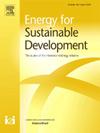Contributors to the carbon emissions of metropolises at different development levels
IF 4.4
2区 工程技术
Q2 ENERGY & FUELS
引用次数: 0
Abstract
The urbanization process of metropolises in China has accelerated in recent years, with the number of urban residents increasing by 21 % per decade (21 %/10a) and the per capita gross domestic product (per capita GDP) increasing by 120 % per decade (120 %/10a) from 2000 to 2019. In parallel with this rapid economic development, carbon emissions have greatly increased, rising by 141 % in 20 years. Understanding the carbon emission trend and its influencing factors is necessary to find plausible pathways for decarbonization. Using data from the Carbon Emission Accounts and Datasets (CEADs), this study analyses the spatiotemporal variations in urban carbon emissions from 2000 to 2019 via the ridge regression method, and the STIRPAT model is adopted, with provincial capitals in China as an example. The cities are classified into three stages of development (i.e., developed, developing and least developed cities) according to per capita GDP to explore the discrepancy in carbon emissions and influencing factors across different types of cities. (1) Urban carbon emissions show a fluctuating upwards trend for the overall sample, with yearly growth rates of 8 % per annum (8 %/a) for 2000–2009 and 2 % per annum (2 %/a) for 2010–2019. (2) For developed cities, affluence is the most significant influencing factor, followed by urbanization rate and energy intensity. In developing cities, carbon emissions initially increased rapidly and then presented a decelerating growth rate, with the main influencing factors being affluence, energy structure and industry structure. In the least developed cities, carbon emissions present a persistent increasing trend and are influenced mainly by affluence, energy structure and urbanization rate. (3) To coordinate economic benefits and carbon emissions, developed cities need to focus on reducing energy consumption, whereas developing cities need to accelerate energy and industrial transformation. For the least developed cities, strong emission reduction efforts may start later for socioeconomic reasons.
不同发展水平的大都市碳排放的贡献者
近年来,中国大都市城市化进程加快,2000年至2019年,城市居民数量每十年增长21% (21% /10a),人均国内生产总值(per capita GDP)每十年增长120% (120% /10a)。在经济快速发展的同时,碳排放量也大大增加,在20年内增长了141%。了解碳排放趋势及其影响因素是寻找合理的脱碳途径的必要条件。利用中国碳排放账户与数据集(CEADs)数据,采用岭回归方法,以中国省会城市为例,分析了2000 - 2019年中国城市碳排放的时空变化特征。根据人均GDP将城市划分为发达、发展中和最不发达三个发展阶段,探讨不同类型城市碳排放差异及其影响因素。(1)城市碳排放总体呈波动上升趋势,2000-2009年年均增长率为8% (8% /a), 2010-2019年年均增长率为2% (2% /a)。(2)对于发达城市,富裕程度是最显著的影响因素,其次是城市化率和能源强度。发展中城市碳排放呈现先快速增长后增速放缓的趋势,主要影响因素为富裕程度、能源结构和产业结构。最不发达城市的碳排放呈持续增长趋势,主要受富裕程度、能源结构和城市化率的影响。(3)为协调经济效益和碳排放,发达城市应注重降低能耗,发展中城市应加快能源和产业转型。对于最不发达的城市,由于社会经济原因,强有力的减排努力可能会晚些开始。
本文章由计算机程序翻译,如有差异,请以英文原文为准。
求助全文
约1分钟内获得全文
求助全文
来源期刊

Energy for Sustainable Development
ENERGY & FUELS-ENERGY & FUELS
CiteScore
8.10
自引率
9.10%
发文量
187
审稿时长
6-12 weeks
期刊介绍:
Published on behalf of the International Energy Initiative, Energy for Sustainable Development is the journal for decision makers, managers, consultants, policy makers, planners and researchers in both government and non-government organizations. It publishes original research and reviews about energy in developing countries, sustainable development, energy resources, technologies, policies and interactions.
 求助内容:
求助内容: 应助结果提醒方式:
应助结果提醒方式:


